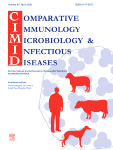Ver ítem
- xmlui.general.dspace_homeCentros Regionales y EEAsCentro Regional Buenos Aires SurEEA BalcarceArtículos científicosxmlui.ArtifactBrowser.ItemViewer.trail
- Inicio
- Centros Regionales y EEAs
- Centro Regional Buenos Aires Sur
- EEA Balcarce
- Artículos científicos
- Ver ítem
Delayed-type hypersensitivity skin test against Neospora caninum in heifers with undetectable specific antibodies
Resumen
Delayed-type hypersensitivity (DTH) has been used in human and veterinary medicine as a skin testing for evaluating in vivocell-mediated immune responses (CMIR). Whereas CMIR is a key process to control intracellular pathogens, its value at identifying cattle exposed to the abortigenic intracellular coccidian parasite Neospora caninum is unknown. In this work, we have evaluated a DTH skin testing in cattle exposed to N. caninum and still seronegative.
[ver mas...]
Delayed-type hypersensitivity (DTH) has been used in human and veterinary medicine as a skin testing for evaluating in vivocell-mediated immune responses (CMIR). Whereas CMIR is a key process to control intracellular pathogens, its value at identifying cattle exposed to the abortigenic intracellular coccidian parasite Neospora caninum is unknown. In this work, we have evaluated a DTH skin testing in cattle exposed to N. caninum and still seronegative. Female calves were experimentally sensitized by subcutaneous (SC) inoculation with live tachyzoites of N. caninum (NC-Argentina LP1) in sterile phosphate-buffered saline (PBS) (group A; n: 8) whereas other calveswere mock-sensitized with PBS (group B; n: 6). Two DTH skin tests were performed by intradermal inoculation with a soluble lysate of N. caninum tachyzoites (NC-Argentina LP1) in the neck region at 60d and 960 d after sensitization. Skinfold thickness at the intradermal inoculation site was measured at 0, 24, 48 h post each DTH skin test and skin biopsies taken for microscopic evaluation. Specific N. caninum antibodies kinetics was evaluated all throughthe experiment. We found that whereas N. caninum specific antibodies remained below the ELISA cut-off, a distinctive skinfold thickness increase was detected in sensitized animals (group A) at the DTH skin test site, showing induration, swelling and inflammatory infiltration. Mock sensitized animals (group B) showed no skinfold thickness growth and lacked specific antibody response. Thus, N. caninum DTH skin testing could be a useful diagnostic tool for the detection of CMIR during N. caninum infection in non-humoral responders
[Cerrar]

Autor
Fiorani, Franco;
Hecker, Yanina;
Cirone, Karina Mariela;
Armendano, Joaquín Ignacio;
Gual, Ignacio;
Campero, Lucía María;
Wilkowsky, Silvina Elizabeth;
Cobo, Eduardo Rubén;
Corva, Pablo;
Morrell, Eleonora Lidia;
Canton, German Jose;
Moore, Prando Dadin;
Fuente
Comparative Immunology, Microbiology and Infectious Diseases 72 : 101522 (2020)
Fecha
2020-07-19
Editorial
Elsevier
ISSN
0147-9571
Formato
pdf
Tipo de documento
artículo
Palabras Claves
Derechos de acceso
Restringido
 Excepto donde se diga explicitamente, este item se publica bajo la siguiente descripción: Creative Commons Attribution-NonCommercial-ShareAlike 2.5 Unported (CC BY-NC-SA 2.5)
Excepto donde se diga explicitamente, este item se publica bajo la siguiente descripción: Creative Commons Attribution-NonCommercial-ShareAlike 2.5 Unported (CC BY-NC-SA 2.5)

